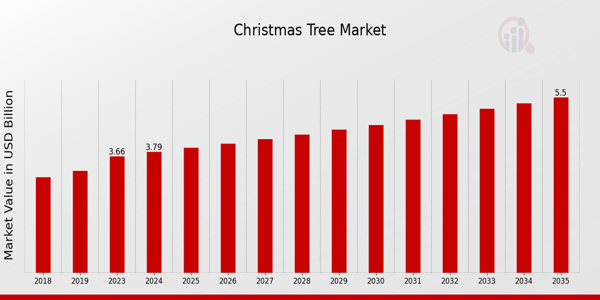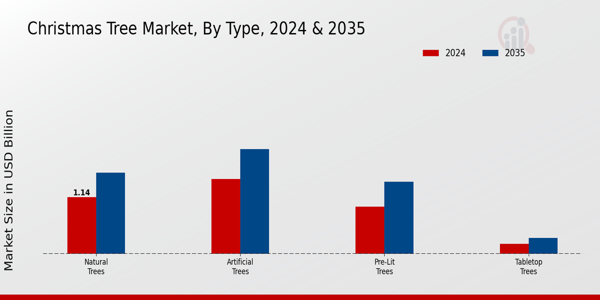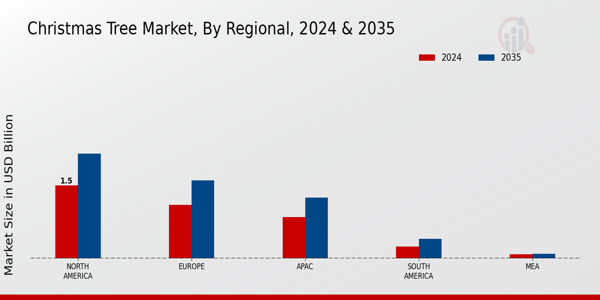Christmas Tree Market Overview
Christmas Tree Market Size was estimated at 3.66 (USD Billion) in 2023. The Christmas Tree Market Industry is expected to grow from 3.79 (USD Billion) in 2024 to 5.5 (USD Billion) by 2035. The Christmas Tree Market CAGR (growth rate) is expected to be around 3.44% during the forecast period (2025 - 2035).

Key Christmas Tree Market Trends Highlighted
The Christmas Tree Market is influenced by several key market drivers, primarily the growing culture of holiday celebrations and gift-giving among families and individuals. This festive season has witnessed a surge in consumer spending, encouraging families to invest in both traditional and artificial Christmas trees. The rise in disposable income, particularly in emerging economies, has made holiday products more accessible to a diverse audience. Moreover, innovations in tree design and sustainability practices in product manufacturing have also contributed to the market's growth, as consumers increasingly seek eco-friendly options that align with their values.
There are notable opportunities to be explored within this market as well. E-commerce platforms present a significant avenue for retailers to reach a broader audience, especially during the holiday season. By enhancing online visibility and user experience, businesses can effectively tap into this trend of increasing online shopping. Furthermore, the demand for customizable products is rising, allowing consumers to personalize their holiday decorations. This creates room for brands to offer unique and tailored solutions that cater to individual preferences, which enhances customer loyalty. Trends in recent times highlight a shift towards sustainability, with many consumers opting for environmentally friendly options.This includes a preference for real trees sourced from sustainable farms as well as high-quality artificial trees designed to last for many years. Another trend is the integration of technology into holiday decorations, such as smart Christmas trees equipped with features like LED lighting and remote control functions. As consumers continue to embrace innovative and sustainable choices, the market is likely to evolve, showcasing more diverse offerings and helping brands adapt to changing consumer expectations. Overall, the Christmas Tree Market continues to evolve in response to shifts in consumer preferences and market dynamics, showcasing a vibrant landscape of opportunities and innovations.
Christmas Tree Market Drivers
Growing Popularity of Eco-Friendly Goods
Eco-friendly products are an emerging trend in the Christmas Tree Market Industry, thus bringing organic Christmas trees into the fold. As the eco-conscious consumer market gives rise, climate change and sustainability compliance aid families in choosing trees grown without pesticides and unnatural hormones. Additionally, eco-conscious consumers find artificial Christmas trees made of various biodegradable and recyclable materials very appealing.
Such sustainable demands provide support to the market as they coincide with the constant ecological values residents have. Following this demand, retailers are also joining in by providing multiple options leading to overall expansion in the Christmas Tree Market. The trend resonates with consumers who prefer products that promote sustainability, which is rapidly becoming an important consideration for purchasing decisions. All the modifications made by businesses in response to this trend will strengthen the Christmas Tree Market and increase consumer loyalty while reaching new customers.
Rising Disposable Income
The increasing disposable income among consumers globally contributes significantly to the growth of the Christmas Tree Market Industry. As households have more financial resources to allocate towards festive decorations and celebrations, the demand for high-quality and aesthetically pleasing Christmas trees has surged. With more money to spend, families are more inclined to purchase not only traditional natural trees but also luxurious artificial trees that can be reused for many years.This trend has led to an increase in the diversity and quality of Christmas tree options available in the market, catering to various tastes and preferences. The segmentation of buyers with higher spending capacity reflects positively on the overall market valuation.
Increased Adoption of Artificial Christmas Trees
The growing popularity and adoption of artificial Christmas trees is a key driver in the Christmas Tree Market Industry. Consumers are increasingly looking for convenience and longevity associated with artificial trees. Unlike natural trees that require regular watering and proper disposal post-holiday, artificial trees can be reused year after year, making them a practical choice for many. Their availability in various styles, sizes, and colors also appeals to a broader audience, enabling buyers to choose options that fit their home décor.The maintenance-free characteristic of artificial trees contributes to their growing market share, as busy consumers appreciate solutions that save time and effort during the festive season.
Christmas Tree Market Segment Insights:
Christmas Tree Market Type Insights
The Christmas Tree Market is comprised of various types that serve different consumer preferences, with Natural Trees, Artificial Trees, Pre-Lit Trees, and Tabletop Trees being the primary classifications. In 2024, the market is projected to witness significant revenue, reflecting the ongoing popularity of Christmas traditions. Out of these types, Natural Trees hold a notable position, valued at 1.14 USD Billion in 2024 and expected to be worth 1.63 USD Billion by 2035. This segment appeals to consumers who prefer an organic holiday experience and the scent of fresh pine, which enhances the festive atmosphere. Meanwhile, Artificial Trees represent another substantial category, initially valued at 1.5 USD Billion in 2024 and increasing to 2.1 USD Billion by 2035. This type is favored for its convenience, longevity, and availability in various styles, making it a dominant choice for families looking for reusable options.
Pre-Lit Trees contribute significantly to market growth as they combine the qualities of Artificial Trees with the added benefit of built-in lighting, which simplifies the decoration process. Valued at 0.95 USD Billion in 2024 and projected to reach 1.45 USD Billion by 2035, this segment is essential for consumers seeking hassle-free holiday preparations. On the other hand, Tabletop Trees, which cater to consumers with limited space, hold a niche market position. Valued at 0.2 USD Billion in 2024 and expected to grow to 0.32 USD Billion by 2035, this segment is significant for smaller homes or apartments, providing flexibility and charm without taking up much room. The diversity among these types reflects both the preferences of consumers and the broader trends toward convenience and sustainability in the Christmas Tree Market, where different segments serve varied needs throughout the holiday season. As this market evolves, it responds to consumer demands for both traditional and modern options, thus enhancing the overall experience associated with Christmas decorations.

Christmas Tree Market Material Insights
The Christmas Tree Market revenue reflects a diverse landscape, with the Material segment playing a pivotal role. By 2024, the entire market is expected to reach a valuation of 3.79 billion USD. This segment encapsulates various materials such as Plastic, Wood, Metal, Glass, and Fiber Optic, each contributing unique characteristics and aesthetic value to Christmas tree decorations. Plastic trees are popular for their durability and variety in designs, while Wood brings a touch of traditional charm and sustainability. Metal and Glass trees often cater to niche markets looking for distinctive style and elegance in their festivities.Fiber Optic trees have gained traction for their captivating light displays, often appealing to tech-savvy consumers. The Christmas Tree Market statistics indicate that trends driving this segment include changing consumer preferences towards eco-friendly options, enhanced product innovations, and seasonal marketing strategies. Challenges include competition with natural trees and increasing raw material costs. Nonetheless, the opportunity lies in expanding product lines and adopting sustainable practices that resonate with growing environmental awareness among consumers.The growth in this segment illustrates the evolving nature of consumer demands within the broader Christmas Tree Market industry, signaling a steady progression in market growth.
Christmas Tree Market Size Insights
The Christmas Tree Market revenue is anticipated to witness significant growth, with expectations for the overall market to be valued at 3.79 billion USD in 2024. The Size segment has become a crucial aspect of market segmentation, as it caters to various consumer preferences and living space needs. Sizes range from Under 4 Feet to Above 10 Feet, with the 4 to 6 Feet and 6 to 8 Feet categories often dominating due to their suitability for most residential spaces, making them highly appealing to consumers. Moreover, the demand for smaller trees, particularly those Under 4 Feet, has seen an uptick as urbanization increases and living spaces become smaller, providing an opportunity for growth in this segment.On the other hand, larger trees, especially those Above 10 Feet, tend to be significant during the holiday season for commercial displays and large gatherings, contributing to overall market trends. The diversity across the size spectrum enhances the Christmas Tree Market statistics, catering to various customer segments while presenting growth opportunities resulting from shifting consumer preferences and seasonal demand. The market growth is further supported by the trend of personalized decorations and themed installations, making size a critical factor in consumer choices.
Christmas Tree Market Sales Channel Insights
The Christmas Tree Market is experiencing various dynamics within the Sales Channel segment, which plays a crucial role in shaping market trends and consumer purchasing behavior. By 2024, the overall market is expected to be valued at 3.79 billion USD, highlighting significant consumer interest and spending during the holiday season. Among the various channels, Online Retail has witnessed considerable growth, catering to the shift toward digital shopping where convenience drives buying decisions. Department Stores remain a traditional favorite, providing a tactile experience for customers, while Home Improvement Stores appeal to those seeking a blend of home décor and festive spirit.Additionally, Specialty Stores targeting niche markets are essential, offering unique products that often draw in dedicated consumer bases. The combination of these channels contributes to diverse Christmas Tree Market revenue sources, promoting accessibility for different consumer demographics. Factors such as changing consumer behavior increased disposable income, and a growing trend of early holiday buying continue to influence market growth, while challenges such as supply chain disruptions and seasonal variability pose important considerations for stakeholders in the Christmas Tree Market industry.Overall, these dynamics create robust opportunities for market expansion and innovation.
Christmas Tree Market Regional Insights
The Christmas Tree Market shows considerable variation across different regions, with North America dominating the market, valued at 1.5 USD Billion in 2024 and projected to reach 2.15 USD Billion by 2035. This region holds a significant share due to high consumer demand during the festive season, reinforcing its importance in the Christmas Tree Market industry. Europe follows closely, valued at 1.1 USD Billion in 2024 and expected to grow to 1.6 USD Billion by 2035, driven by tradition and robust retail presence. The APAC region, valued at 0.85 USD Billion in 2024, is also witnessing growth, projected to reach 1.25 USD Billion by 2035, as holiday celebrations gain popularity among the middle class.South America and MEA hold the lowest market shares, valued at 0.25 and 0.09 USD Billion, respectively, in 2024. However, there is potential for growth in these regions as cultural acceptance of Christmas festivities increases over time. Overall, the Christmas Tree Market statistics reflect diverse regional characteristics that shape market dynamics, influenced by local traditions, economic factors, and consumer behavior.

Christmas Tree Market Key Players and Competitive Insights:
The Christmas Tree Market offers a diverse landscape characterized by a blend of traditional and emerging trends. This market is highly competitive, with several players vying for consumer attention through innovative products, marketing strategies, and sustainable practices. Seasonal fluctuations influence the production and sales dynamics, as the peak periods coincide with the holiday season when consumers are more inclined to purchase Christmas trees, both real and artificial. Market participants need to stay attuned to consumer preferences, which have shifted notably towards eco-friendly options and customizable products. As sustainability practices gain prominence, competitors are increasingly focusing on sourcing materials responsibly and offering products that cater to environmental concerns. Understanding market dynamics, consumer behaviors, and the competitive landscape is crucial for key players aiming to maintain or enhance their market position.A Christmas Place stands out in the competitive realm of the Christmas Tree Market due to its expansive product range and commitment to high-quality offerings. The company has cultivated a strong brand identity that resonates with holiday enthusiasts, often characterized by a wide selection of themed decorations and high-quality artificial Christmas trees. With a robust online presence complemented by physical retail locations, A Christmas Place effectively engages with a diverse customer base. Its strengths lie in the ability to anticipate customer needs, showcasing the latest trends and incorporating seasonal innovations into its product lines. Furthermore, A Christmas Place emphasizes customer experience, ensuring that shoppers have access to expert advice and personalized recommendations. This focus on customer satisfaction and quality has positioned the company favorably within the competitive landscape.Christmas Tree Shops has carved out a niche in the Christmas Tree Market, leveraging its unique retail model to appeal to budget-conscious consumers. The company is recognized for providing a distinct shopping experience, marked by a diverse inventory that includes both traditional and contemporary Christmas trees along with a wide array of seasonal décor. Its strengths lie in creating an inviting atmosphere that encourages exploration and discovery among customers. The store layout and product displays are designed to enhance the festive shopping experience, making it an attractive destination during the holiday season. Additionally, Christmas Tree Shops effectively utilizes promotional strategies to drive foot traffic, often offering competitive prices that underline its commitment to affordability. This combination of an inviting shopping environment and a value-oriented approach has solidified Christmas Tree Shops as a key player in the Christmas Tree Market.
Key Companies in the Christmas Tree Market Include:
- A Christmas Place
- Christmas Tree Shops
- Northlight Seasonal
- Balsam Hill
- Glittering Christmas
- Gerson Company
- Fraser Fir
- Katherine's Collection
- Vickerman Company
- American Tree Company
- Evergreen Enterprises
- Sandy's Christmas Trees
- Cedar Hill Farm
- National Tree Company
- Holiday Wonders
Christmas Tree Market Industry Developments
The Christmas Tree Market has been witnessing significant developments and trends recently. Companies like Balsam Hill and National Tree Company are focusing on enhancing their product lines with innovative and more realistic artificial trees to cater to changing consumer preferences. The demand for sustainable and environmentally friendly options is also on the rise, prompting companies such as Evergreen Enterprises and Gerson Company to invest in eco-friendly products. Additionally, there have been notable shifts in market valuations, reflecting a growing interest in the holiday decor sector, which is being driven by an uptick in holiday spending and a resurgence of in-person celebrations post-pandemic. Merger and acquisition activities have been relatively scarce among the targeted companies, but collaboration among players, especially in e-commerce and distribution, is becoming more prevalent to adapt to the evolving retail landscape. Christmas Tree Shops, Northlight Seasonal, and Katherine's Collection are also adjusting their strategies to leverage social media marketing and e-commerce to reach wider audiences. Overall, the market is adjusting to shifting consumer demands and preferences while simultaneously dealing with supply chain challenges that have been affecting many industries.
Christmas Tree Market Segmentation Insights
Christmas Tree Market Type Outlook
- Natural Trees
- Artificial Trees
- Pre-Lit Trees
- Tabletop Trees
Christmas Tree Market Material Outlook
- Plastic
- Wood
- Metal
- Glass
- Fiber Optic
Christmas Tree Market Size Outlook
- Under 4 Feet
- 4 to 6 Feet
- 6 to 8 Feet
- 8 to 10 Feet
- Above 10 Feet
Christmas Tree Market Sales Channel Outlook
- Online Retail
- Department Stores
- Home Improvement Stores
- Specialty Stores
Christmas Tree Market Regional Outlook
- North America
- Europe
- South America
- Asia Pacific
- Middle East and Africa
| Report Attribute/Metric |
Details |
| Market Size 2023 |
3.66 (USD Billion) |
| Market Size 2024 |
3.79 (USD Billion) |
| Market Size 2035 |
5.5 (USD Billion) |
| Compound Annual Growth Rate (CAGR) |
3.44% (2025 - 2035) |
| Report Coverage |
Revenue Forecast, Competitive Landscape, Growth Factors, and Trends |
| Base Year |
2024 |
| Market Forecast Period |
2025 - 2035 |
| Historical Data |
2019 - 2024 |
| Market Forecast Units |
USD Billion |
| Key Companies Profiled |
A Christmas Place, Christmas Tree Shops, Northlight Seasonal, Balsam Hill, Glittering Christmas, Gerson Company, Fraser Fir, Katherine's Collection, Vickerman Company, American Tree Company, Evergreen Enterprises, Sandy's Christmas Trees, Cedar Hill Farm, National Tree Company, Holiday Wonders |
| Segments Covered |
Type, Material, Size, Sales Channel, Regional |
| Key Market Opportunities |
Sustainable tree options growth, E-commerce sales expansion, Innovative decor products, growing consumer interest in experiences, Increasing eco-consciousness among buyers |
| Key Market Dynamics |
Sustainability trends, Seasonal demand fluctuations, E-commerce growth, regional preferences, Rising disposable incomes |
| Countries Covered |
North America, Europe, APAC, South America, MEA |
Frequently Asked Questions (FAQ) :
The Christmas Tree Market is expected to be valued at approximately 3.79 USD Billion in 2024.
By 2035, the Christmas Tree Market is projected to reach a value of about 5.5 USD Billion.
The Christmas Tree Market is anticipated to grow at a CAGR of 3.44% from 2025 to 2035.
North America is expected to dominate the market with a value of around 1.5 USD Billion in 2024.
The market size for Artificial Trees is estimated to be approximately 1.5 USD Billion in 2024.
The market size for Pre-Lit Trees is projected to be around 1.45 USD Billion by 2035.
Major players in the market include A Christmas Place, Balsam Hill, and National Tree Company, among others.
The Europe market is expected to reach approximately 1.6 USD Billion by 2035.
The APAC region's market is projected to grow from 0.85 USD Billion in 2024 to approximately 1.25 USD Billion by 2035.
The market is segmented into Natural Trees, Artificial Trees, Pre-Lit Trees, and Tabletop Trees.

















